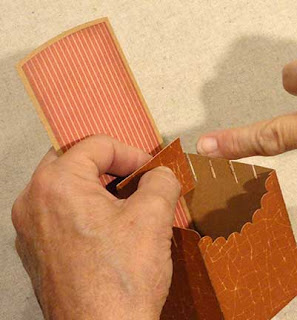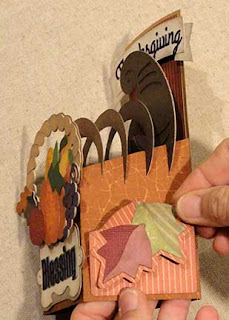Perky little dimensional box is assembled as a hexagon base
with sturdy lid that has a projecting rim,
cubic stem, and added two-layer leaf.
Two-hole punched layered label offers place
for customization. Create one as a unique gift container,
or as autumn, Halloween or Thanksgiving decor.
Size is approx. 5.5" tall x 3.5" wide x 3.25" deep.
ASSEMBLY:
1. Identify and cut the shapes:
A lid dome wedges (6)
B lid dome base
C base hole cover
D stem "box"
E dome accent shapes
F lid rim "bump out" shapes (2)
G box (base) body with accent shapes
H box rim top hex ring
I box base hole cover
J two layer leaf
K swirl tendril
L tag two parts
2. Prepare the box base by bending back on all vertical perforations, and on all horizontal perforations except the top tab perforations - bend these forward.
3. Form the base body into a tube to bring the side straight edge to overlap the opposite tab perforation line. Apply adhesive to the tab face, overlap, adjust for top and bottom alignment, then join the seam.
4. Bend the bottom contour edges inward, one at a time, to bring the straight edges to overlap the adjacent tab perforation lines. Glue them, inward seam, then moving toward the end, to shape the bottom of the pumpkin base box.
Complete all 6 seams in this fashion.
Complete all 6 seams in this fashion.
5. Fold the bottom tabs inward to perpendicular positions.
Fold the bottom hex "ring" into position, then glue each box tab to the underside of the ring. Reach fingers into the opening to apply pressure or make adjustments.
NOTE: it may be helpful to first adjust and glue the edge opposite the connected edge, then adjust the two sides between the "connected" edges.

6. Apply glue to the hex ring face, then position, adjust and attach the opening cover with edges matching.
7. At the top of the box, apply glue to the underside of the (6) first (non tab) sections of the rim. Bend these rims into the interior of the box to attach to the backside of the box interior.
The tabs should all remain unattached, and bent perpendicular toward the center of the box cavity. (They become the attachment "shelf" for the stabilizing hex ring in the next step.)
8. Apply glue to the tab "shelf" faces, then insert and adjust the hex ring.
9. Attach the (6) main decor side shapes to each wall of the base box. Here, the punch hole wall accent shape is shown.
The accent shapes will have a little "offset" space margin all around.
Also position and attach the lower accent strips in the first trapezoid face below the main box wall.
10. To build the lid, follow this LINK to the tutorial for the fir hydrant box (the lid for the pumpkin is identical to the fire hydrant). Complete steps 15 thru 28, then return to this post to complete the project.
NOTE that the stem for the pumpkin has a slightly angled shape that is different from the hydrant top "stem".
NOTE that the stem for the pumpkin has a slightly angled shape that is different from the hydrant top "stem".
11. Bend the lid accent shapes on the perforations, then apply glue and attach, centered, in each of the faces of the lid.
12. Position and attach the opening cover between the extensions of the flanges.
13. Layer the label tag and attach to the box with twine or narrow ribbon (and glue, if desired).
14. Layer the leaf shapes. Add curl to the tendril swirls. Attach these to the lid by gluing the top end lobe in the desired position near the stem.
15. To place the lid on the box, fit the flange extensions inside the edges of the base rim.
Here is the completed pumpkin box.










































































